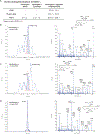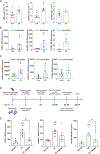15-epi-lipoxin A5 promotes neutrophil exit from exudates for clearance by splenic macrophages
- PMID: 38989570
- PMCID: PMC11344644
- DOI: 10.1096/fj.202400610R
15-epi-lipoxin A5 promotes neutrophil exit from exudates for clearance by splenic macrophages
Abstract
Specialized proresolving mediators (SPMs) promote local macrophage efferocytosis but excess leukocytes early in inflammation require additional leukocyte clearance mechanism for resolution. Here, neutrophil clearance mechanisms from localized acute inflammation were investigated in mouse dorsal air pouches. 15-HEPE (15-hydroxy-5Z,8Z,11Z,13E,17Z-eicosapentaenoic acid) levels were increased in the exudates. Activated human neutrophils converted 15-HEPE to lipoxin A5 (5S,6R,15S-trihydroxy-7E,9E,11Z,13E,17Z-eicosapentaenoic acid), 15-epi-lipoxin A5 (5S,6R,15R-trihydroxy-7E,9E,11Z,13E,17Z-eicosapentaenoic acid), and resolvin E4 (RvE4; 5S,15S-dihydroxy-6E,8Z,11Z,13E,17Z-eicosapentaenoic acid). Exogenous 15-epi-lipoxin A5, 15-epi-lipoxin A4 and a structural lipoxin mimetic significantly decreased exudate neutrophils and increased local tissue macrophage efferocytosis, with comparison to naproxen. 15-epi-lipoxin A5 also cleared exudate neutrophils faster than the apparent local capacity for stimulated macrophage efferocytosis, so the fate of exudate neutrophils was tracked with CD45.1 variant neutrophils. 15-epi-lipoxin A5 augmented the exit of adoptively transferred neutrophils from the pouch exudate to the spleen, and significantly increased splenic SIRPa+ and MARCO+ macrophage efferocytosis. Together, these findings demonstrate new systemic resolution mechanisms for 15-epi-lipoxin A5 and RvE4 in localized tissue inflammation, which distally engage the spleen to activate macrophage efferocytosis for the clearance of tissue exudate neutrophils.
Keywords: 15‐HEPE; air pouch; efferocytosis; resolution of inflammation; specialized proresolving mediators.
© 2024 Federation of American Societies for Experimental Biology.
Conflict of interest statement
Declaration of Interest
B.D.L. and C.N.S are inventors on patents (SPMs) assigned to Brigham and Women’s Hospital which are managed according to conflict of interest policies. All other authors declare no conflict of interest.
Figures







Similar articles
-
Plasminogen and plasmin induce specialized proresolving mediators and promote efferocytosis via 5-lipoxygenase.J Thromb Haemost. 2025 Jun;23(6):1988-1995. doi: 10.1016/j.jtha.2025.03.018. Epub 2025 Mar 25. J Thromb Haemost. 2025. PMID: 40147777
-
Garcinoic acid enhances inflammation resolution against colitis by activating Nrf2 dependent efferocytosis.Free Radic Biol Med. 2025 Sep;237:37-45. doi: 10.1016/j.freeradbiomed.2025.05.428. Epub 2025 May 29. Free Radic Biol Med. 2025. PMID: 40449807
-
The eosinophil chemoattractant 5-oxo-ETE and the OXE receptor.Prog Lipid Res. 2013 Oct;52(4):651-65. doi: 10.1016/j.plipres.2013.09.001. Epub 2013 Sep 19. Prog Lipid Res. 2013. PMID: 24056189 Free PMC article. Review.
-
A New E-Series Resolvin: RvE4 Stereochemistry and Function in Efferocytosis of Inflammation-Resolution.Front Immunol. 2021 Feb 10;11:631319. doi: 10.3389/fimmu.2020.631319. eCollection 2020. Front Immunol. 2021. PMID: 33643307 Free PMC article.
-
Resolution of innate immune cells with proresolving lipid mediators in idiopathic pulmonary fibrosis.J Leukoc Biol. 2025 Jul 9;117(7):qiaf100. doi: 10.1093/jleuko/qiaf100. J Leukoc Biol. 2025. PMID: 40605609 Review.
Cited by
-
Efferocytosis in tissue engineering: A comprehensive review of emerging therapeutic strategies for enhanced tissue repair and regeneration.Bioact Mater. 2025 Jun 9;52:155-181. doi: 10.1016/j.bioactmat.2025.05.026. eCollection 2025 Oct. Bioact Mater. 2025. PMID: 40585383 Free PMC article. Review.
References
-
- Norris PC, Skulas-Ray AC, Riley I, Richter CK, Kris-Etherton PM, Jensen GL, Serhan CN, and Maddipati KR (2018) Identification of specialized pro-resolving mediator clusters from healthy adults after intravenous low-dose endotoxin and omega-3 supplementation: a methodological validation. Scientific Reports 8, 18050. - PMC - PubMed
-
- Bannenberg GL, Chiang N, Ariel A, Arita M, Tjonahen E, Gotlinger KH, Hong S, and Serhan CN (2005) Molecular Circuits of Resolution: Formation and Actions of Resolvins and Protectins1. The Journal of Immunology 174, 4345–4355 - PubMed
-
- Yona S, Kim K-W, Wolf Y, Mildner A, Varol D, Breker M, Strauss-Ayali D, Viukov S, Guilliams M, Misharin A, Hume David A., Perlman H, Malissen B, Zelzer E, and Jung S (2013) Fate Mapping Reveals Origins and Dynamics of Monocytes and Tissue Macrophages under Homeostasis. Immunity 38, 79–91 - PMC - PubMed
MeSH terms
Substances
Grants and funding
LinkOut - more resources
Full Text Sources
Research Materials
Miscellaneous

